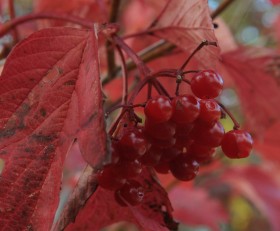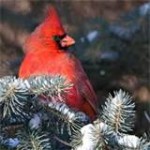 The Friends of Crossroads did their usual fine job of making the Collins Learning Center festive for Christmas, but our forests also seem ready for the holidays with ruby-red highbush cranberries contrasting with the green of conifers.
The Friends of Crossroads did their usual fine job of making the Collins Learning Center festive for Christmas, but our forests also seem ready for the holidays with ruby-red highbush cranberries contrasting with the green of conifers.
We need not worry about the birds stripping these berries from the shrubs. Highbush cranberries are unpalatable, to say the least. Next spring, after they have fermented, birds will find them quite a bit more appealing. And it will be easy for birds to find the red fruit.
Scientists speculate that birds have better color vision that humans. This is still being investigated, but evidence suggests that most birds see the same colors we do, but that they are more sensitive to the red end of the spectrum.
Let’s face it: it’s got to be tough to give an eye examination to a bird. But behavior indicates that many birds show a preference for red food.
Anatomical studies reveal that daylight-feeding birds have high numbers of color-receiving cells and also curious little red, orange and yellow droplets in their retinas. Inclusive but plausible explanations for these droplets are that they are filters—increasing the perception of red. If this is so, red berries must stand out like neon against the drab (in a bird’s eye view) background of green. This explains why holly berries are bright red among the shiny leaves of green.
This time of year, especially on windy days, our evergreen forests are the best places to search for woodpeckers, chickadees and nuthatches. Sparrow and finches will be in the unmowed upland areas of the property. Fruit-eating birds will be hanging out in the old apple trees, looking for red fruit. We know this because, for years, we have participated in the the annual Sturgeon Bay Christmas Bird Count.
 On Saturday, December 15 this year, Sturgeon Bay birders will be a part of a 113 year old tradition in which bird watchers and scientists, families and individuals take a day out of the busy holiday season to count all of the birds they see in an assigned area.
On Saturday, December 15 this year, Sturgeon Bay birders will be a part of a 113 year old tradition in which bird watchers and scientists, families and individuals take a day out of the busy holiday season to count all of the birds they see in an assigned area.
Most experienced birders have already received assignments from Charlotte Lukes, the local coordinator/compiler, but Crossroads welcomes beginners to take part in this citizen science effort. While the event runs from pre-dawn to dark, Crossroads will offer public hikes from 9:00 to 10:30 and from 1:30 to 2:00. Meet at the Collins Learning Center.
According to the Audubon Society: “The long term perspective made possible by the Christmas Bird Count is vital for conservationists. It informs strategies to protect birds and their habitat – and helps identify environmental issues with implications for people as well. For example, local trends in bird populations can indicate habitat fragmentation or signal an immediate environmental threat, such as groundwater contamination or poisoning from improper use of pesticides.”
It is also likely that invasive species are crowding out plants which are food sources for winter birds and nesting habits of our breeding birds.
On Wednesday, December 19 at 1:00, DCIST (the Door County Invasive Species Team) presents Laura MacFarland, an invasive species specialist with the River Alliance of Wisconsin, who will talk about her work with the River Alliance and the up-and-coming invasive threats to our waterways.There are a number of river and wetland invasive plants that haven’t made it to our are yet, and early detection is a key component of invasive species management. This program is free and open to the public.

